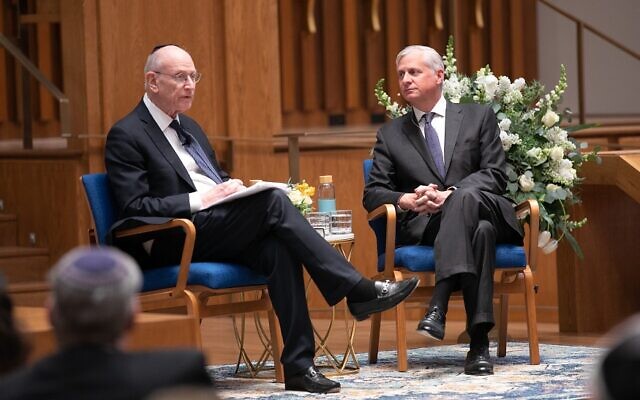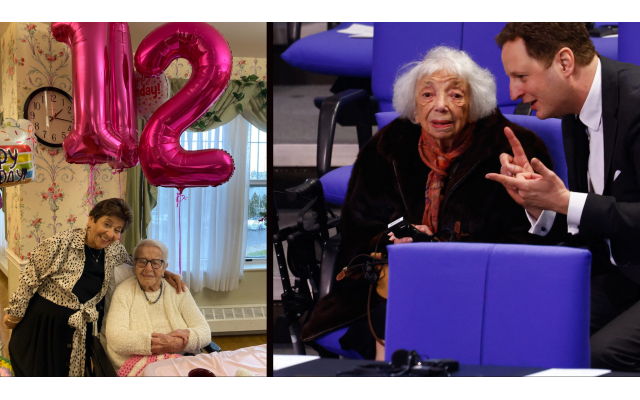Report: Official Holocaust Survivor Count Drops
JF&CS Atlanta reports that more than half of its survivor clients receive Medicaid and nearly half also food stamps.
Dave Schechter is a veteran journalist whose career includes writing and producing reports from Israel and elsewhere in the Middle East.
The United States is home to 38,400 Jewish Holocaust survivors — down from 50,000 two years ago and 109,900 in 2003.
A report released Jan. 23 by the Claims Conference, the organization that negotiates reparations with Germany, estimated that, as of August 2023, there were 245,000 Jewish survivors worldwide — nearly two-thirds fewer than in 2003.
According to “The Global Demographic Report on Jewish Holocaust Survivors,” the U.S. accounted for 15.7 percent of the current population. Spread across more than 90 countries, 48.8 percent lived in Israel, 18.1 percent in North America, 17.5 percent in Western Europe, 11.8 percent in countries of the former Soviet Union, 2.5 percent in Eastern Europe, and the remainder in Oceania, South America and the Caribbean, Africa, and Asia.
The report was released in advance of International Holocaust Remembrance Day on Jan. 27.
The U.S. trailed only Israel, which was home to 119,000 Jewish survivors. In the U.S., 90 percent lived in 10 states, led by nearly 40 percent in New York, followed by California with 16 percent. In descending order, the others are Florida, Illinois, New Jersey, Massachusetts, Pennsylvania, Maryland, Ohio, and Michigan.
The median age of survivors worldwide is 86 years old. They range in age from 77 to 112, with 20 percent older than 90. Some 95 percent are “child survivors,” born between 1928 and 1946 (a small number were in utero in 1945 and born the next year). An estimated 61 percent are female and 39 percent male.
“The data we have amassed not only tells us how many and where survivors are, it clearly indicates that most survivors are at a period of life where their need for care and services is growing. Now is the time to double down on our attention on this waning population,” Gideon Taylor, President of the Claims Conference, said in a statement.
Since its founding in 1951, the Claims Conference has negotiated more than $90 billion in compensation from the German government for suffering and losses resulting from Nazi persecution. Recipients have been Jews persecuted in Europe, the former Soviet Union, and parts of North Africa occupied by the Nazis or their Axis allies.

Atlanta native Ambassador Stuart Eizenstat has served since 2008 as Special Negotiator for the Claims Conference. In a June 2023 statement, he said, “I am inspired that, as shown by the extraordinary results we have achieved this year, so many decades after the end of World War II, far from waning, the German government and its people continue to feel a deep responsibility to provide additional care to Holocaust survivors . . . Every negotiation is a near-last opportunity to ensure survivors of the Holocaust are receiving some measure of justice and a chance at the dignity that was taken from them in their youth. It will never be enough until the last survivor has taken their last breath.”
For 2024, the Claims Conference negotiated $435 million in direct compensation and $888 million for home health care services.
Given that some survivors may choose not to be identified and others who may not consider themselves to be survivors, the report concedes that “the estimate of 245,000 represents the lower-bound on the total number of survivors alive today.”
The U.S. trailed only Israel, which was home to 119,000 Jewish survivors. In the U.S., 90 percent lived in 10 states, led by nearly 40 percent in New York, followed by California with 16 percent. In descending order, the others are Florida, Illinois, New Jersey, Massachusetts, Pennsylvania, Maryland, Ohio, and Michigan.
There is no official definition of a Holocaust survivor. Yad Vashem, the Holocaust memorial and museum in Israel, refers to “Jews who lived for any amount of time under Nazi domination, direct or indirect, and survived . . . From a larger perspective, other destitute Jewish refugees who escaped their countries fleeing the invading German army, including those who spent years and, in many cases, died deep in the Soviet Union, may also be considered Holocaust survivors.”
The United States Holocaust Memorial Museum in Washington, D.C. “honors as survivors any persons, Jewish or non-Jewish, who were displaced, persecuted, or discriminated against due to the racial, religious, ethnic, social, and political policies of the Nazis and their collaborators between 1933 and 1945. In addition to former inmates of concentration camps, ghettos and prisons, this definition includes, among others, people who were refugees or were in hiding.”
The funds negotiated by the Claims Conference support more than 300 social service agencies worldwide, among them Jewish Family & Career Services Atlanta. JF&CS assists survivors with home care, house cleaning, meal delivery, transportation, medical equipment, and adult daycare, medical and dental care, and prescriptions.
JF&CS estimates that more than 230 survivors live in Georgia, mostly in the Atlanta area, though there may be others not known to the agency. Its database lists 177 survivors receiving services through JF&CS and another 57 others who engage with JF&CS programming.

The Claims Conference estimated that 47 percent of survivors alive today were born in the former Soviet Union. Amy Neuman, program manager of Holocaust survivor services, said that 86 percent of its clients in Georgia are from the former Soviet Union.
Outside of Georgia, JF&CS also manages grant programs for the Claims Conference in a 10-state region: South Carolina, North Carolina, Virginia, Alabama, Mississippi, Arkansas, Louisiana, Oklahoma, and sections of Florida and Texas. In that region, JF&CS serves another 104 survivors. South Florida is not part of the region, but other areas of the state are included.
Even as the survivor population declines, the demand for services has remained steady or in some places increased, as survivors who previously did not need help are now enrolled. Additionally, the cost of providing these services continues to increase.

That is reflected in Claims Conference allocations for 2024: $3.22 million to support JF&CS services in the Atlanta area, an increase of more than one-third since 2022, and $3.83 million elsewhere in its region, double the amount two years ago.
The Claims Conference requires that 88 percent of its funds be used for home services. Neuman credited funds from the Jewish Federation of Greater Atlanta for helping fill the gaps.
Service providers continue to estimate that roughly one-third of U.S. survivors live below the federal poverty line. Neuman said that more than half of its clients in Georgia and in the 10-state region are on Medicaid, the federal-state program that funds health care for low-income individuals, and 45 to 50 percent also receive food stamps.
JF&CS asks that anyone who knows of Holocaust survivors in Georgia needing assistance call 770-677-9382 and for those elsewhere in the region call 770-677-9360 or go through the website at jfcsatl.org.
- News
- Community
- Dave Schechter
- Holocaust Survivors
- Claims Conference
- Global Demographic Report on Jewish Holocaust Survivors
- International Holocaust Remembrance Day
- Gideon Taylor
- Stuart Eizenstat
- World War II
- Yad Vashem
- United States Holocaust Memorial Museum
- Jewish Family & Career Services
- Amy Neuman
- jewish federation of greater atlanta




comments